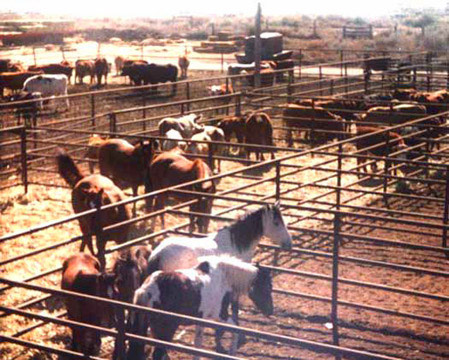

Three Fillies, continued ...
The next morning, Saturday, we got back on the job of finding a foal we could resell at the benefit auction. We decided to make our first visit to another of Mildred's finds: the Cattleman's Livestock Auction.
The auction was located in Belen, south of Albuquerque in the Rio Grande valley. The parking lot was the size of several football fields. Small children walked around the parking lot hawking chickens, baby rabbits and puppies cradled in their arms. Grownups sat on the backs of their pickups peddling saddles or hay or Navajo jewelry or used 55-gallon drums. We could hear a half dozen languages in the parking lot -- English, Spanish, Navajo, and the many tongues of the Pueblo peoples.
To the east of the parking lot loomed a tall metal building. Behind it spread acres of pipe bar corrals thronged with hundreds of sheep, goats, cattle and horses. Above them ran a precarious catwalk from which would-be buyers could inspect the stock.
Trucks hauling stock trailers snaked toward the unloading chute, which ran into the maze of pipe bar corrals and runways. Two men wearing the badges of the State Livestock Board checked the paperwork of each seller against reports of stolen livestock. As the officials certified each head of livestock, an auction employee would glue a tag to it. This carried a bar code and a number large enough to read from some 50 ft away. Since much of the livestock was totally wild, attaching these tags was not easy. The procedure is to glob glue on the back of a tag and toss it at the animal's back.
Scene from the Cattlemen's Livestock Auction
This day, dozens of grown horses thronged the pens, but only two foals. One was a red appaloosa colt with white blanket and big spots on his rump. He seemed nonchalant about his surroundings. Who knows, I thought. He may already be tame.The other was a blood-bay filly. She appeared to be around 7 months of age. She was in a pen with two mares. She began nursing off one.
The three of them, besides their different ages, looked as alike as peas in a pod. They were small, fine-boned, with roman noses and sloping rumps. The two mares had manes hanging to their knees, and tails that dragged the ground. On their left shoulders they all bore a bar N brand. I didn't know it then, but this is the brand of all free-range horses of the Navajo nation.
The brand on the filly was raw and peeling. She and the two mares flinched and stared at their surroundings. I guessed they were as wild as any herd could be who only saw humans at a yearly roundup for branding and taking culls. These must have been the culls; the horses McCoy told us were shipped to slaughter every week.
I wrote down the numbers on the bar-coded tags of the two foals. I climbed down from the catwalk, and strode into the office. A lady at the front desk looked up the tag numbers for me. The appaloosa was from a local farm. The filly had been hauled in from the high plains of Winslow, Arizona. Navajo country.
